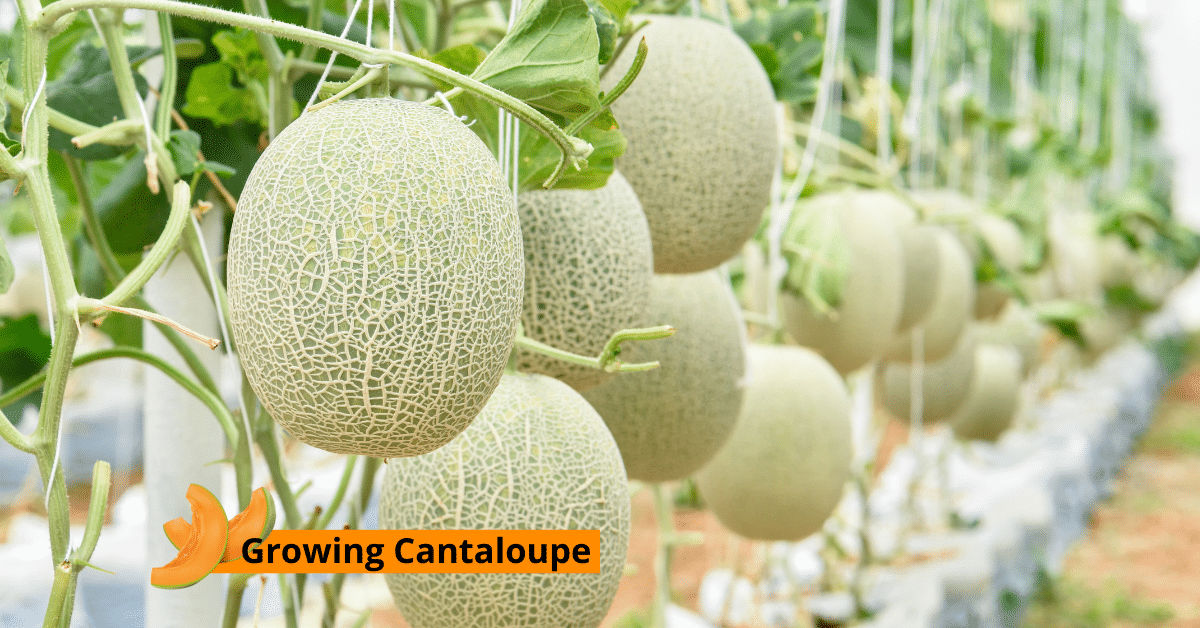Planting, Growing, and Harvesting Cantaloupe
Growing cantaloupe, Belonging to the Cucurbitaceae family, cantaloupes are one of the widely consumed variants of melon across the globe. They are known by various names in different parts of the world, like rockmelon, sweet melon, and spanspek.
The smallest cantaloupe can weigh less than 500 grams, while the heaviest recorded variant falls in the range of 5 kilograms. The name of the fruit got derived in the 18th century from Italian cantaloupe, a papal country near Rome.
Biological Name
Cucumis melo var. cantalupensis.
Plant Type
Fruit Type.
Maturity Period
The plant takes about 80-90 days to bear fruit.
Maturity Size
They can reach a height of about 12-18 inches.
Soil Type
They require loamy soil with well-rotted compost enrichment.
Soil pH
A pH of 6-6.8 suits the plant to thrive.
Exposure
The plant needs at least 8 hours of direct sunlight during its growth period.
Hardiness (USDA Zone)
The hardiness zone for cantaloupe lies in 4-11.
Spacing
A spacing of about 3-4 feet must get maintained when calculated from row to row.
Bloom Time
The blooming starts in late February and lasts till July.
Toxity
Non-Toxic.
Flower Color
They generally come in orange.
Growth Rate
They take about 80 days to grow and bloom.
Native Zone
They are native to South Asia and Africa.
Maintenance
Proper watering systems coupled with systematic adding of fertilizers to the soil are some of the simplest methods one can follow to maintain the cultivation efficiently.
History:
The mention of cantaloupe got found in the history books back in 1739 in English literature. The fruit got introduced to the Italian palate from Armenia back in the 18th century. The origination of the fruit raises a lot of questions; however, some historians pinpointed areas close to South Asia to Africa.
In 1890, the edible fruit got introduced to the European people and later became a commercial crop of the USA. Historians often consider cantaloupe cultivation one of the first fruit to get domesticated and cultivated for commercial purposes.
Nutritional facts of cantaloupe:
A small slice of juicy cantaloupe is a treat on a hot summer noon. Like every watermelon variety, the fruit is loaded with water and constitutes about 90% of the total weight. The high Vitamin A, C content of cantaloupe makes it high up on the list of every health-conscious people.
According to the USDA, the beta carotene contents of the fruit can knock apricots, grapefruits, and oranges content for a home run. The beta carotene content in the fruit gives it the radiant colors it and, once consumed, can get converted to powerful antioxidants that play an essential role in neutralizing free radicals that attack the human body.
Vitamin A, an antioxidant present in the fruit, helps a human maintain eye health, good red blood cell count, and improves the existing immune system. The Vitamin C content in cantaloupe can meet the delay recommended limit in the human body and helps the body fighting diseases such as asthma, cancer, and diabetes.
Planting, Growing, and Harvesting Cantaloupe
Vitamin C plays an essential role in generating new blood vessels, cartilages, and muscles in the human body. Folic acid in the fruit that later gets converted to Vitamin B-9 helps prevent neural tube congenital disabilities like spinal Bifida. The consumption of folic acid showed promising results in countering cancer risks and counter issues such as memory loss related to aging.
When a layperson checks the fiber content in a fruit, the first thing that crosses their mind is the positive bowel movement. However, a person on recommended fiber diet can overcome problems related to heart disease and even shown a positive effect on people on weight loss programs.
Essential electrolyte mineral called potassium plays a vital role in the health of the nerve and muscle contraction. Minerals such as Vitamin K, niacin, choline, calcium, and magnesium are present in the fruit but a low percentage.
Nutrients and Minerals for the Cantaloupe Plant:
Like most fruit-generating plants, melons require nitrogen-rich soil for juicy fruit generation and healthy growth of the plant. Using aged compost or manure can meet the nitrogen demand of the plant efficiently. However, experts always advise newbie cultivators to go for a soil test before adding any fertilizers to the soil while growing melons.
While planting cantaloupe seeds to the ground, adding nitrogen-rich fertilizers to the earth helps the plant’s initial growth. Once the cantaloupe seedlings start flowering, agricultural experts advise cultivators to switch to a fertilizer rich in potassium and phosphorous.
Growing cantaloupe in optimal conditions, the soil should remain rich in these three macronutrients. The use of regular NPK fertilizers may do the job, but the desired yield may not get achieved. Adding compost to the soil and fertilizers helps improve the soil structure, adds essential micronutrients, and significantly enhances the water retention capacity of the earth.
When to Plant Cantaloupe Plant:
People can start growing cantaloupe from cantaloupe seeds or buy a small plant from the nursery and sow them in the soil. The soil should remain rich in nitrogen and organic compost to give proper nutrients and soil structure for a healthy growth that later gets converted to a high yield. Cultivators residing in colder countries should prefer using young plants to sow in the soil to improve survival.
However, cultivators of colder countries looking to grow cantaloupe from seeds can plant them indoors at least 4-6 weeks before the spring frost. The vines generated from the cantaloupe seeds are tender and should not get transplanted unless all the frost risks get eliminated.
A soil temperature of about 60 degrees F helps the plant to grow comfortably. People living in warmer countries can easily sow cantaloupe seedlings in the soil outdoor once the temperature reaches the degrees mentioned above.
Where to Plant Cantaloupe Plant:
The cantaloupe growing soil should get prepared properly by adding fertilizers; cultivators widely use slow-releasing nitrogen fertilizers to the ground and add water to the earth to give a proper mix.
A soil possessing a well-drained structure and a combination of loamy and sandy should do the job efficiently. Picking a spot that receives ample sunlight for at least 8 hours plays an important role when deciding the growth and fruit production of particular cultivation.
Sunlight also reduced the risk of any fungal and microbial infections of the cantaloupe leaves from the wet foliage. Growing cantaloupe in raised beds and platforms helps the soil with a sound drainage system as the vine-type plant cannot withstand water at the roots.
Adding aged compost before plating cantaloupe seedlings helps the ground with the needed micronutrients that play a considerable role in the growth. Mulching the soil using black plastic serves as a good solution in regions where the soil temperature drops below 60 degrees F, prevents weed enrichment and developing clean fruit.
How to Grow Cantaloupe Plant:
A lot of the yield from growing cantaloupe depends on how the cultivators plant the seedling in the soil. According to the experts, a cultivator should dig a 1-inch deep hole and maintain a spacing of about 18 inches between sowing two cantaloupe seeds.
As the plant belongs to the vine category, adding a trellis helps the plant get structural support and reach the desired height. A soil test needs to get done before sowing seeds to the soil, and according to the result of the examination, adding liquid nitrogen fertilizer will help the growth.
However, once the vines start blooming, the cultivator should move from nitrogen-heavy fertilizer to potassium and phosphorous fertilizers to prevent lots of foliage production and minimum yield. Pests such as squash bugs and vine borers are some of the biggest enemies of the plant, and adding row covers helps the cultivation.
Cantaloupe Plant Care:
Watering the plant plays a vital role in the growth of the cantaloupe plants. A growing cantaloupe plant requires about 1-2 inches per square foot of water per week. Watering the plant in the morning gives it ample time to keep it dry once the sun goes down.
A plant with wet foliage can become a breeding ground for several microbial organisms. Drip Irrigation used by several large-scale cultivators proved to fetch good results. Adding mulch to the soil surface prevents evaporation of water from the soil and retains more moisture within.
Once the fruit starts growing, start reducing the water as dry, hot weather fetches juicy and sweet melons; pruning the plant once the plant begins fruiting helps generate more enormous melons instead of small and more significant numbers of melons. Pollination helps the plant as the stem blooms both male and female flowers.
Types of Cantaloupe:
Several types of cantaloupe get cultivated across the globe; we tried to list some of the most popular variants:
- Ambrosia: They are among the sweetest variants and takes about 85 days to mature.
- Athena: The variant produces fruits weighing around 5-6 pounds and takes about 70-80 days to mature.
- Hale’s Best Jumbo: They are some of the most aromatic melons one can find among all other variants. They take about 90 days to mature and weighs in the range of 3 pounds.
- Bush Star: These varieties of melons take very little garden space and get preferred by cultivators who get restricted by space. They roughly take about 90 days to mature and become ready for consumption.
How to Harvest and Store Cantaloupe:
Cantaloupe picking begins once the exterior of the fruit starts changing from green to tan or yellow color. A cantaloupe picked early tastes bland and will disappoint any consumer hoping for that sweet juicy taste.
The stem possessing the ripped cantaloupe will show small cracks, which can get used as an indicator. Cantaloupe picking should not require much effort and should get detached easily from the vines. In situations where the fruit falls off from the plant indicates the cantaloupe has over ripped.
Harvesting cantaloupe season sets in when vines start getting dry and cracks start appearing. Melons tend to get softer once detached from the plant, but sugar generation inside the fruit will continue to take place off the vines. They have a brief span when they are off the vines, and an undissected cantaloupe can last up to 5-6 days, while a dissected one lasts about three days when kept in refrigerated condition wrapped inside a plastic.
Pests and Disease:
- Gummy stem blight: A common fungal disease found with growing cantaloupe cultivation caused by the fungus Didymella bryoniae. They impart a brown or tan color to the cantaloupe leaves of the affected plant. They often attack the fruit, leaving them to rot and called black rot. There are no variants resistant to this fungal attack, and it generally occurs from the infected seeds. Purchasing seeds from a reputed nursery and using crop rotation can bring some relief to the cultivator.
- Anthracnose: Colletotrichum orbicular fungus takes its time to attack the plant that has wet leaves and foliage. They get commonly found in cultivation areas receiving many rainy seasons every year. It is using fungicides to tackle the disease generated good outcomes.
- Alternaria leaf Spot: The fungus causes small circular, tan spots to appear on the leaves. They thrive in bright sunlight, frequent rains, and temperatures ranging within 60-9- degrees F.
Recipes:
- Cantaloupe sorbet.
- Spiced cantaloupe tea loaf.
- Cantaloupe salsa.
When should a cultivator sow the seeds for cantaloupe cultivation?
How to grow cantaloupe best?
What plant should not get planted near cantaloupe cultivation?
How to know that cantaloupe becomes ready for harvest?
What fertilizers suits best cantaloupe cultivation?
Are cantaloupes easy to grow?
What is cantaloupe plant care?
Systematically adding fertilizers to the soil.
Adding mulch to the soil surface to improve moisture retention.
Pruning the stems to generate better yield.

